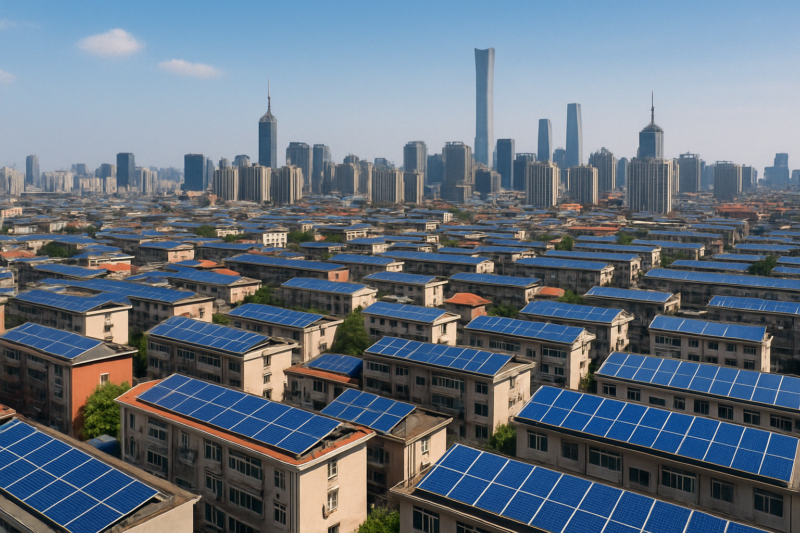Sign up for CleanTechnica’s Weekly Substack for Zach and Scott’s in-depth analyses and high level summaries, sign up for our daily newsletter, and/or follow us on Google News!

China’s coal-fired electricity generation took an unexpectedly sharp turn downward in the first quarter of 2025, signaling a potentially profound shift in the world’s largest coal-consuming economy. This wasn’t merely a seasonal dip or economic distress signal; rather, it represented a clear and structural turning point. Coal generation fell by approximately 4.7% year over year, significantly outpacing the overall grid electricity supply decline of just 1.3%. However, electricity demand, a better measure, went up by 1%. What gives?
Notably, that modest decline in grid electricity supply wasn’t evenly distributed across the entire quarter—it was confined to two of the three months, where heating requirements were softened by warmer than average months in January and February. This detail matters, indicating that the reduction in coal-generated electricity wasn’t primarily driven by a widespread drop in economic activity or power use, but rather by underlying transformations in China’s energy supply.
Looking closer, the slight rise in coal usage within China’s steel sector reinforces this interpretation. Coal consumed for steelmaking edged upward by around 2%, driven by stable, slightly growing crude steel production. Stable steel production is often a reliable barometer of industrial economic activity, suggesting that China’s broader economic fundamentals remained solid, even as coal-fired electricity generation declined.
In the first quarter of 2025, China’s steel industry saw a notable increase in exports, rising approximately 6% year over year to reach 27.4 million tonnes. This robust export performance occurred despite ongoing global trade tensions and heightened tariff barriers, particularly from Western markets. The strong export figures indicate resilience within the industry, reflecting competitive pricing and continued global demand for Chinese steel products. This somewhat reflects China’s firms getting their exports in before tariffs kick in, so this may change over the year, but firms are also aggressively expanding to new markets globally.
Simultaneously, China’s steel sector is undergoing a gradual but meaningful shift toward electric arc furnace (EAF) technology, which uses China’s 260 to 280 million tons of domestic scrap metal rather than traditional iron ore and coal-intensive blast furnaces. The sustained strength in steel exports, coupled with a strategic transition toward cleaner EAF production, underscores a more sustainable trajectory for China’s steel sector, even amid external economic pressures and internal policy constraints. It’s likely coal demand for steel will be declining soon too, after being relatively flat for the past handful of years as China’s infrastructure boom comes to an end. For context, steel consumes about a third of the coal that electrical generation does in China, so the increase in steel coal demand is much lower than the decrease in generation coal demand, about 5 million tons up compared to 20 million tons down for a net 15 million ton decline in the country.
The steel story aligns with official Chinese assertions of 5.4% growth for Q1. While wishful thinkers are asserting China’s economy is in the dumpster and others might suggest the tariffs are hurting China’s economy, the underlying statistics of increased electricity and steel demand bely that.
To make sense of this apparent paradox—a significant decline in coal-generated electricity alongside growing electricity demand—we need to examine what’s been happening quietly behind the scenes: the explosive growth of distributed, behind-the-meter solar photovoltaic (PV) systems. According to China’s National Energy Administration (NEA), the country added roughly 120 gigawatts (GW) of new distributed solar capacity in 2024 alone, reaching approximately 370 GW of cumulative installed capacity by the year’s end. This growth trend continued aggressively into the first half of 2025, as developers rushed to commission installations before scheduled tariff reforms took effect. China’s behind-the-meter solar capacity is likely to exceed 430 GW by mid-2025, adding an enormous amount of hidden, decentralized electricity generation capacity that isn’t fully reflected in official generation statistics.
As I discussed with Shanghai-based China energy expert David Fishman of the Lantau Group recently, China put in place a Whole County Rooftop Solar Promotion Program. Developers had to bid on an entire county’s rooftop solar at once, committing to putting solar on 50% of government buildings, 40% of public institutions, 30% of commercial and industrial rooftops, and 20% of rural homes. That’s paid off massively in the densely populated southeast of the country where demand is highest and free space is lowest.
Per industry analysis from Ember and Climate Energy Finance, this rapid proliferation of distributed solar has significant implications. Unlike traditional grid-connected utility-scale plants, distributed solar generation is often omitted or severely undercounted in official generation statistics produced by entities like China’s National Bureau of Statistics (NBS). As a result, tens of terawatt-hours (TWh) of electricity generated by these rooftop systems are effectively invisible when interpreting China’s national grid-supplied electricity data. This has profound implications: the reported 1.3% decline in grid electricity generation does not represent true reduced consumption, but rather a substitution effect—electricity generated behind the meter directly displacing grid-supplied power.
Estimating the actual impact is instructive. In the first quarter of 2024, behind-the-meter solar generation likely totaled around 80 TWh. By the first quarter of 2025, given significant capacity growth and better solar conditions, quarterly generation from behind-the-meter systems could have risen to between 100 and 120 TWh—an increase of perhaps 30 to 40 TWh compared to early 2024. Given that China’s reported 1.3% drop in grid-delivered electricity in early 2025 equates to roughly 30 TWh less generation, it’s reasonable to conclude that this hidden solar growth alone might account for much, if not all, of the decline. In practical terms, rooftop solar capacity additions have invisibly flattened the growth in China’s grid electricity demand, effectively masking what would otherwise have been modestly growing consumption.
China’s dramatic shift toward distributed solar is not just a statistical curiosity; it represents a major structural transformation in the world’s largest electricity market. According to analysis from the China Electricity Council (CEC), renewables like wind and solar accounted for the vast majority of incremental electricity demand growth in recent years, a trend that is only accelerating. The rapid expansion of rooftop solar is directly displacing traditional fossil-fuel generation, especially coal, reducing both emissions and dependence on centralized fossil infrastructure. This decentralization of generation, while complicating data interpretation, substantially advances China’s transition away from coal.
Looking ahead, there is strong evidence to suggest that China’s coal-fired electricity generation has now peaked after seeing very modest 0.2% growth in 2024 due to an extended heat wave combined with weaker than expected hydroelectric, entering a permanent decline trajectory. A combination of continued aggressive renewable installations—both large-scale and distributed—as well as policy mandates to peak coal consumption and emissions by mid-decade, reinforces this conclusion. The International Energy Agency (IEA) has noted similar structural shifts globally, but China’s scale and speed are uniquely impactful. China’s policymakers remain committed to ambitious renewable capacity targets, efficiency improvements, and structural energy reforms, positioning the country for sustained coal generation declines year over year from now onward.
This quiet and partly hidden shift to behind-the-meter solar has far-reaching implications. It suggests that China’s recent electricity data must be interpreted carefully. A small dip in reported grid demand is no longer indicative solely of economic softness; it might equally reflect success in energy transition, masked by decentralized renewable generation. Over the coming years, this hidden solar generation—though challenging for statisticians and grid planners—will likely accelerate coal’s decline, reshaping both China’s energy landscape and the global climate outlook. The first quarter of 2025, therefore, will likely be remembered not merely as a momentary blip, but as the pivot point toward China’s enduring transition away from coal.
Whether you have solar power or not, please complete our latest solar power survey.
Have a tip for CleanTechnica? Want to advertise? Want to suggest a guest for our CleanTech Talk podcast? Contact us here.
Sign up for our daily newsletter for 15 new cleantech stories a day. Or sign up for our weekly one if daily is too frequent.
CleanTechnica uses affiliate links. See our policy here.
CleanTechnica’s Comment Policy



